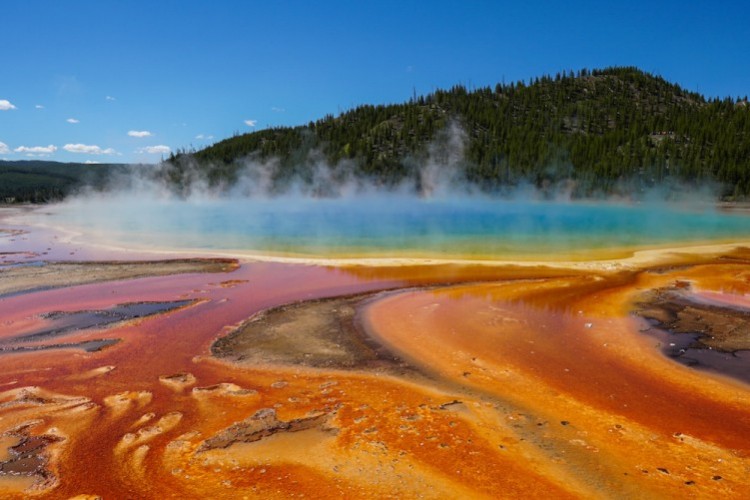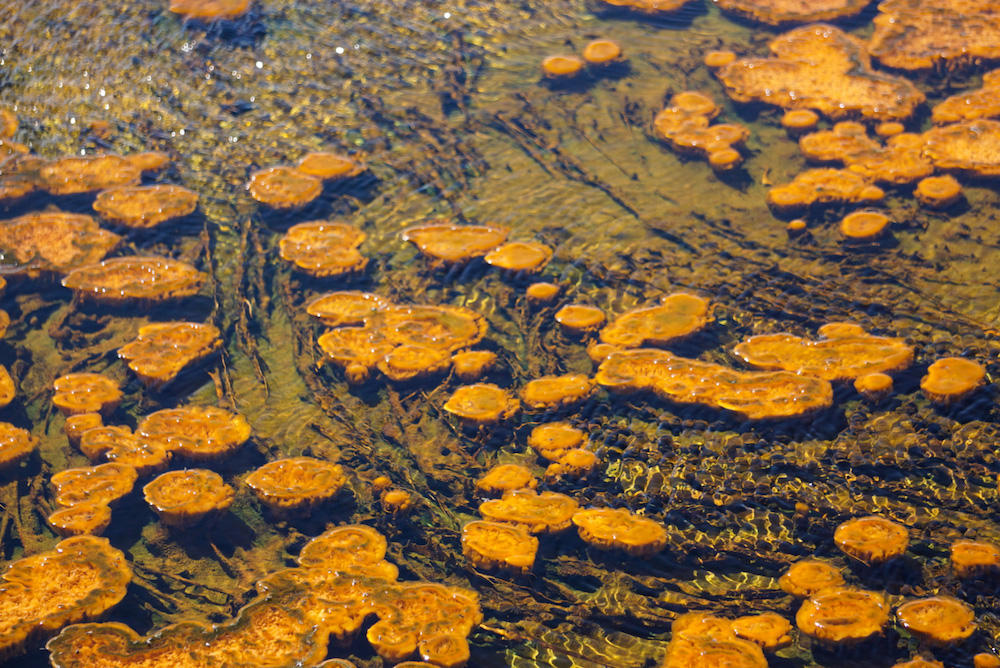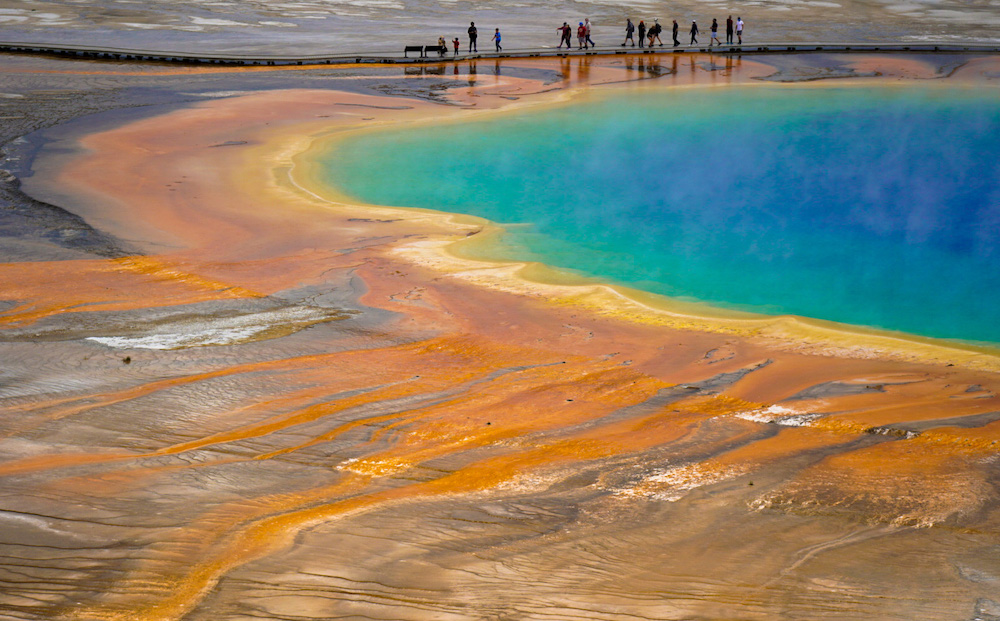Yellowstone’s Thermophiles and the Fight Against COVID-19

As COVID-19 infected the world one year ago, infectious disease experts scrambled to slow the spread and work towards a vaccine. Using a now common practice known as the Polymerase Chain Reaction (PCR) microbiologists were able to rapidly replicate DNA, enabling the covid tests many of us have taken while helping with the development of the vaccine itself. What you might not know is that none of this would have been possible without Yellowstone’s microbial life.
Thanks to the work of an exceptionally curious microbiologist in the 1960’s, the power of PCR was eventually unlocked, saving countless lives. Today we seek to better understand this groundbreaking microbial discovery and the role basic research plays in the advancement of science and our understanding of the world.
The Diverse Microbial Life of Yellowstone
Yellowstone National Park (YNP) has long been admired for its megafauna and robust thermal activity. Today park visitors enjoy the sights of stampeding bison, lumbering grizzlies and rutting elk. For over a century geysers, like Old Faithful, drew tourists from around the world to watch its routine eruptions, but what most park visitors overlooked was just beneath the surface.
The inhabitants of hot springs, known as thermophiles, and their true potential went largely unnoticed until a microbiologist, named Thomas Brock, made his first trip to YNP in 1964. Brock’s discovery started as curiosity driven basic research, but led to advancement in an array of studies including genetic research, forensic studies, and even rapid COVID-19 testing.
Brock, then a professor at Indiana University, was on a road trip to the west coast when he decided to stop in YNP to break up the drive. He immediately noticed the colorful microbial mats that lined the hot springs teeming with life in the most extreme conditions. The next summer, he returned to YNP with a student research team and a grant from the National Science Foundation to research life at high temperatures. It was the start of what would become a decade of work studying the park's microscopic creatures. This basic research led to the discovery of Thermus aquaticus (TaQ), a heat loving bacteria, which would go on to change the world.
Yellowstone Microbes Love the Heat!
TaQ is a unique bacteria because it can thrive at temperatures upwards of 176 degrees fahrenheit. For a long time the upper temperature limit for organisms was thought to be 122 degrees fahrenheit, the point at which proteins denature, or be destroyed.
For example, Eggs are rich in protein. Crack open an egg, and it is loose and viscous, but when heat is added it solidifies into a hard-boiled egg. The process is called denaturing, a permanent change in the cellular structure of the egg.
Thermophiles like TaQ are composed of enzymes, proteins that carry out important functions in the cell, that do not break down at high temperatures. This is the principal quality that makes it the perfect candidate to lend its enzymes to one of the most important discoveries in microbiology in history, the polymerase chain reaction (PCR).
Thermus aquaticus Changes the World
Decades after Brock’s discovery of TaQ, biochemist Kary Mullis was awarded the Nobel Peace Prize for his invention of PCR in 1993. The reaction is a fast and inexpensive way to copy small segments of DNA, creating millions or even billions of copies. Because significant amounts of a sample of DNA are necessary for molecular and genetic analyses, studies of isolated pieces of DNA are nearly impossible without PCR amplification, which is sometimes called molecular photocopying.
Before PCR became widely used in the 1990’s, scientists were forced to cultivate pathogens in a sample of DNA in order to diagnose disease, which is not only time consuming and costly, but also dangerous. The PCR reaction cuts this time, allowing us to rapidly replicate DNA, identifying Covid-19 infections in a matter of days or minutes even! PCR is also used in other medical diagnoses, forensics, food safety, crop development, and even wildlife biology!
A Humble Yellowstone Microbe Helps us Track a Mountain Lion 1500 miles!
While the ability to amplify trace amounts of DNA has seemingly endless applications, PCR found its way back into national news headlines again in 2011. Using PCR, field biologists were able to prove that a mountain lion hit and killed on a Connecticut road, had travelled from the Black Hills of South Dakota, an epic distance of 1500 miles!
Originally researchers presumed that the mountain lion was released or had escaped captivity since the species had not been detected in Connecticut in over 100 years. However DNA sampled from the mountain lion postmortem was matched to scat found in South Dakota, and subsequently Wisconsin and Minnisota, confirming the big cat’s long journey from home. Discoveries like this would have surely gone unnoticed if not for the basic research conducted by Brock decades ago.
The Importance of Curiosity and Basic Research
Basic research and YNP have one very important thing in common, they both benefit from preservation. Without the creation of YNP in 1872, perhaps Brock would have never stopped in the region during his cross country road trip, or maybe the thermal features would have been vandalized and destroyed by pioneers expanding westward. Preservation makes for a more resilient ecosystem, which leads to better science and ultimately a more resilient human race.
Basic research is intended to fill a gap in knowledge without having any particular application at the moment. Therefore, it can often be overlooked as frivolous and unproductive. Some scientists even considered Brock’s research in YNP to be a “vacation study”. Brock’s research, however, illustrates the importance of basic scientific research, how the pursuit of knowledge is a noble one and you “just never know what will happen”, as Brock puts it himself.
While the impact of Brock’s discoveries was not immediately evident, it was nevertheless important work. Brock’s research was simply curiosity driven and in the 1960’s there was no application for the discoveries being made, but without it, scientists like Mullis would not have been able to invent PCR.
Aldo Leopold, considered by many to be the father of wildlife ecology and the United States' wilderness system, emphasized that “to keep every cog and wheel is the first precaution of intelligent tinkering” (Leopold,1949). This famous quote by Leopold is frequently invoked by supporters of the National Parks Service and for good reason. This perspective embodies a view of species, large and small, as parts or components of a larger ecosystem that are worth saving, even when there is little understanding regarding why they might be important.
Preservation of biodiversity is important for a number of reasons, but in the case of Thomas Brock, Mullis, and TaQ, preservation and subsequent basic research allowed us to unlock the power of PCR. While it is impossible to know what other secrets of nature will be unlocked in the future, the best we can do right now is to continue preservation efforts and basic scientific research to fill knowledge gaps.
Ecotour Adventures Naturalist Kirk Ryder is an avid geyser gazer and thermophile enthusiast. When he isn't sharing the Greater Yellowstone Ecosystem with guests, Kirk enjoys seeking out cold water in pursuit of native cutthroat trout.
Learn more:
Applebome, Peter. “Wild Cougar Traveled East 1,500 Miles, Tests Find.” The New York Times, The New York Times, 27 July 2011, www.nytimes.com/2011/07/27/nyregion/wild-cougar-traveled-east-1500-miles-tests-find.html.
Benson, Melinda. “Ecology and Society: Intelligent Tinkering: The Endangered Species Act and Resilience.” Ecology and Society, The Resilience Alliance, 2012, http://www.ecologyandsociety.org/vol17/iss4/art28/#introduction.
Coppinger, James. “Some Like It Hot: The Discovery of Thermus Aquaticus.” http://www.Ncsociology.Org, Torch Magazine, 2019.
“How a Thermophilic Bacterium from a Yellowstone Hot Spring Is Helping the Fight against the COVID-19 Pandemic.” USGS.Gov | Science for a Changing World, U.S. Geological Survey, 2020,https://www.usgs.gov/center-news/how-a-thermophilic-bacterium-a-yellowstone-hot-spring-helping-fight-against-covid-19.
“Polymerase Chain Reaction (PCR) Fact Sheet.” Genome.Gov, National Human Genome Research Institute, 17 Sept. 2020, https://www.genome.gov/about-genomics/fact-sheets/Polymerase-Chain-Reaction-Fact-Sheet.
Shastri, Devi. “How a 1960’s Discovery in Yellowstone Made Millions of Covid-19 PCR Tests Possible.” www.Usatoday.Com, 1 Feb. 2021.















